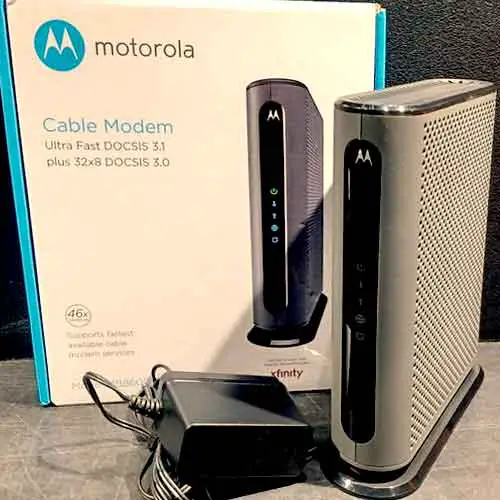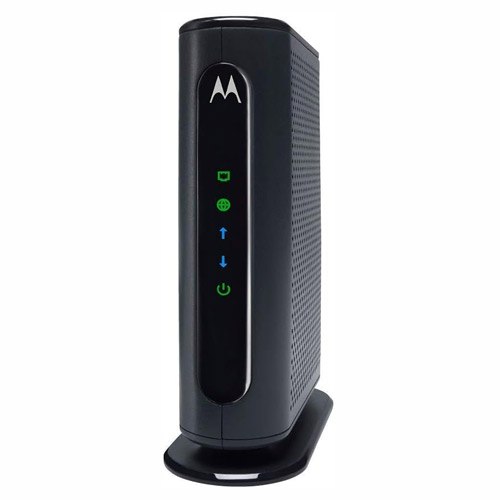Both of the contenders are manufactured by Motorola to work with any Windows, Linux, or Mac Computer, router, or gaming station to provide the ultimate HD streaming and gaming experience.

Both of them meet the latest and secure internet protocol IPv6 which ensures unlimited IP addresses.
Similarities and Differences:
Starting with the similar things between both:
- Both don’t have an in-built router.
- Both offer 2 years of warranty.
- Both of them meet the latest Internet Protocol IPv6.
- Both of them are compatible with major Windows, Mac, or Linus computers, routers, gaming stations, and other devices that have Ethernet ports.
Here the Motorola MB8600:
- has twice the bonded channels in it than its competitor which makes it much faster.
- meets the DOCSIS 3.1 standard while the other meets the DOCSIS 3.0 standard.
- has 4 gigabit Ethernet LAN ports and MB7620 has only one.
- is more expensive than its competitor.
The maximum download and upload speed of Motorola MB7420 is 686 Mbps and 1 Gbps respectively. And for the other its 123 Mbps and 3.8 Gbps respectively.
Compared to MB7420, the Motorola MB8600 is much faster due to having twice the bonding channels and meeting the advanced DOCSIS standard. It has 4 gigabit Ethernet LAN ports while its competitor has only one.
Table of Contents
Side By Side Comparison


Motorola MB7420 is a Motorola cable modem that meets the DOCSIS 3.0 standard.
It has 16 downstream and 4 upstream channels which allows it to receive and send data up to 686 and 123 Mbps respectively.
It allows more channels and accelerates download speed due to Full-Band Capture Digital Tuning.
Unlike its competitor, MB8600 is a Motorola cable modem that meets the DOCSIS 3.1 standard that makes it superior to its competitor in terms of speed and security.
It contains 32 downstream channels and 8 upstream channels which allows it to receive and send data up to 3.8 and 1 Gbps respectively.
| General Specifications | Motorola MB7420 | Motorola MB8600 |
| DOCSIS | 3.0 | 3.1 |
| Downstream channels × Upstream channels | 16 × 4 | 32 × 8 |
| Download Speed | 686 Mbps | 3.8 Gbps |
| Upload Speed (Mbps) | 123 Mbps | 1 Gbps |
| Ethernet ports | 1 × Gigabit | 4 × Gigabit |
| Modem Router | No | No |
How different are they in terms of their Hardware/Design?
Both of the contenders are vertically designed cable modems without having an in-built router in them. Since both of them are made by Motorola, their physical geometry is almost the same.
They have the same elliptical base which gives them an attractive look. In comparison to its competitor, Motorola MB7420 is relatively smaller in size, slightly darker in color, and also lightweight as well.
Motorola MB7420 has only one Gigabit Ethernet LAN port, one coaxial cable connector, one power button along with a power jack, and one configuration reset button on its rear side.
On its front side, there are LEDs indicating lights that show us the status of the modem.
On the rear side, Motorola MB8600 contains 4 Gigabit Ethernet LAN ports, one coaxial cable connector, one reset button, and one power button along with a power jack.
Like its competitor, MB8600 also has LED indicating lights on its front side but also contains two LED indicators for each Ethernet port.
Which modem has better Compatibility?
Both of the contenders are compatible with many types of Network Protocols including the most recent version known as IPv6. It ensures better security, unlimited network addresses, and more efficient connections.
Both of them are recommended by major internet service providers across the globe such as CableLabs, Time Warner Cable, Xfinity Comcast, and many other cable networks.
Furthermore, both of them can be connected with almost any router, PC, HDTVs, gaming station, and other Ethernet-capable devices.
Which device has a better overall Performance?
DOCSIS
DOCSIS is an abbreviation of Data Over Cable Service Interface Specification.
It is an international telecommunication standard that allows higher data transfer over coaxial TV cables.
Among all the DOCSIS versions, DOCSIS 3.1 is the latest of them all and provides far better speed and security than its previous version, DOCSIS 3.0.
Since Motorola MB8600 supports DOCSIS 3.1 version while its competitor supports DOCSIS 3.0 version, then it is obvious that it would provide the best online security and data transfer rate.
Bonded Channels
Channels are like lanes on which data is being sent or received over.
Channel bonding by cable modem is the process of combining multiple channels to increase the amount of traffic that it can support with ease.
Upstream and downstream channels are made for sending and receiving data over cables respectively.
Since MB8600 has twice the bonded channels as its competitor, it would transfer more amount of data in the same amount of time.
| Performance Parameters | Motorola MB7420 | Motorola MB8600 |
| Downstream channels × Upstream channels | 16 × 4 | 32 × 8 |
Data Rate comparison
Data rate determines the speed at which the data is being received or sent over.
It is measured in Megabits per second and Gigabits per second.
Motorola MB8600 would transfer data at a much higher rate than its competitor because of having a maximum number of bonded channels and also meets the 3.1 DOCSIS standard.
| Performance Parameters | Motorola MB7420 | Motorola MB8600 |
| Downstream data rate | 686 Mbps | 3.8 Gbps |
| Upstream data rate | 123 Mbps | 1 Gbps |
Chipset Differences
Data modulation between different modems is carried out by modem chips.
Both of our contenders contain a chipset by Broadcom but of different models/versions.
Motorola MB7420 contains a BCM3384 Broadcom chipset while its competitor has a BCM3390 Broadcom chipset in it.
With multiple gateway interfaces, BCM3390 can provide multi-gigabits per second of data between cable modems. On the other hand, BCM3384 can only provide up to 1 gigabit per second.
Modulation
Modulation can be defined as the process of converting data into radio waves signal for transmission purposes.
It is being done by changing one or more characteristics of the wave.
There are many types of modulation such as Quadrature Amplitude Modulation (QAM) which is being used in MB7420, and Orthogonal Frequency Division Multiplexing (OFDM) which is being used in MB8600.
OFDM modulation is superior to QAM since it combines the benefits of QAM and Frequency Division Multiplexing (FDM), another type of modulation.
OFDM modulation delivers data into multi carriers to avoid any kind of interference and hence has high data rate than its competitor.
Differences in their Interface
There are two types of interfaces in both of the contenders, cable interface and network interface.
The network interface is equipped with auto MDI/MDIX, a Medium Dependent Interface which is used to connect two network devices via twisted-pair cabling.